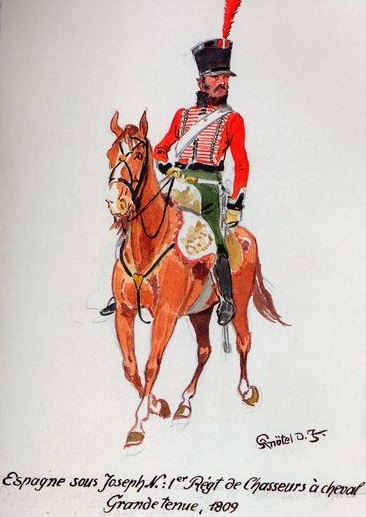1809-1813 King Joseph's Army (Cavalry, Guard, Civic Guard)
1809-1813 King Joseph's Army (Cavalry, Guard, Civic Guard)
The whole subject of the uniforms of Joseph’s Army remains vague despite intensive and devoted research. Little so far published is really reliable.
When King Joseph was forced to flee into France in November 1813, his guard and some Spanish elements of his Army followed him loyally and so passed in one way or another into the French service.
Cavalry
1st Regiment Chasseurs à Cheval, Full Dress, Private, 1809
Being the first Spanish regiment of line cavalry recruited, the 1st Chasseurs à Cheval had been given this showy red pelisse (here worn over the green dolman) to attract recruits. Its trumpeters reportedly had all-crimson uniforms.
1st Regiment Chasseurs à Cheval, Full Dress, Private, 1809
Royal Guard
Royal Guard, Fusilier Regiment, Private, 1810
Formed of select Spaniards, this organization was considered more efficient than the royal guard’s mostly French grenadier and voltigeur regiments.
Claiming to be the legal king of Spain, Joseph gave his troops the traditional Spanish red cockade, even though the Spanish insurgents also wore it.
Royal Guard, Hussar Regiment, Field Uniform, Private, 1812
Note the JN (Joseph Napoleon) on the sabretache. This small (two-squadron) regiment was also composed of Spanish volunteers mixed with men from the Dutch 3rd Hussar Regiment.
Recent research has provided additional information on this uniform. The cuffs of the pelisse should be red, instead of blue; the dolman (here covered by the pelisse) was red with yellow braiding and bright blue cuffs and collar; the hussar sash was red and yellow. For full dress the hussars had tall red plumes, with yellow tips, worn on the left side of the busby. Dress breeches were white with the usual stripes and braiding in yellow. Finally the crown on the sabretache should have red insets.
Royal Guard, Chevau-Léger Regiment, Field Uniform, Private, 1811
This overcoat is more ornate than those of the Old Guard cavalry. Under it, this trooper probably wears an undress uniform coat, to go with his leather-reinforced trousers. The black object behind his lower leg is the bottom of his saddle’s left-side skirt, which passes through a slit in the schabraque, to protect it from the chafing of his leg.
Royal Guard, Chevau-Léger Regiment, Full Dress, Private, 1811
When Joseph moved from the throne of Naples to that of Spain in 1808, he brought along - disregarding Napoleon’s orders - most of the able-bodied men of his royal guard, including this regiment of light cavalry. Its personnel seem to have been mostly Frenchmen with a sprinkling of other nationalities.
Life Guards, Guardsman, 1810
These two squadrons of gardes du corps furnished personal escort outside his palaces. (For inside duty, following Spanish royal practice, he had a company of ornate halberdiers.) They were sometimes termed “Squadrons of Honour,” with the names “Grenada” and “Seville,” which would suggest Spanish soldiers with a French cadre (doubtlessly a strong one).
It is possible that - again following Spanish custom - the two squadrons had different coloured squares on their baldrics.
Civic Guard
Civic Guard, Private, 1811
Elements of these paramilitary police units, which Joseph formed in all cities under his rule, also took refuge in France - possibly less out of loyalty than to escape the vengeance of their fellow Spanish whose lives they had been regulating for the past four or five years.
Note the resemblance of their uniform to that of the French gendarmerie. Oddly, it seems to be one of the best authenticated of Joseph’s armed forces.









Comments
Post a Comment